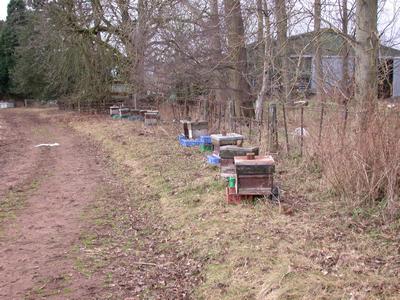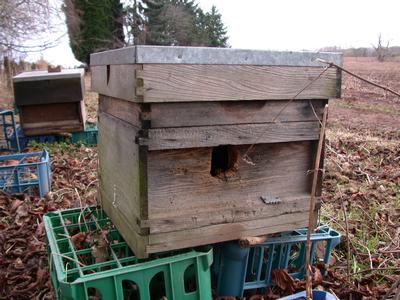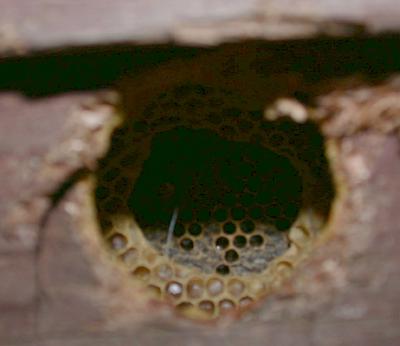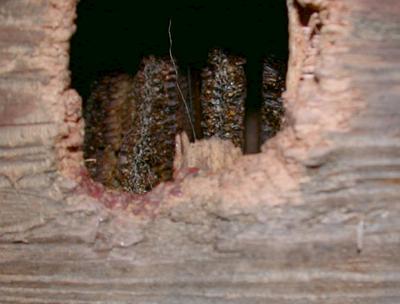 |
| Site of woodpecker damaged beehives |
 |
| Woodpecker damage to beehive |
 |
 |
| Two views of the damaged honeycomb seen through the woodpecker hole |
Worcestershire Record No. 24 April 2008 p. 20
Michael Southall.
 |
| Site of woodpecker damaged beehives |
 |
| Woodpecker damage to beehive |
 |
 |
| Two views of the damaged honeycomb seen through the woodpecker hole |
I reported this to Harry Green who mentioned the attack a few years ago on a hive at Wilden Marsh, and also a wooden shed which had been perforated near Cleeve Prior. I mentioned to him that my concise Birds of the Western Palearctic made no mention of this feeding behaviour. He wrote back and said that the full version of BWP states “that in one hard winter in England there were numerous attacks on hives of bees: large holes drilled in the wood but apparently no bees eaten; birds apparently attracted by humming noise of bees (Ellement 1953) the ref is to the Bedfordshire Naturalist.” I promised to monitor the hives and take some photographs.
I next looked at the hives on the 1st March 2008. The Woodpecker or Woodpeckers had continued to damage the hives. Out of the twelve hives, nine had been damaged, seven had holes, which penetrated, into the hives and two of these had significant holes and interior comb damage. The hive with the large hole had continued to be damaged, with half the comb missing.
When I next looked in early April the beekeeper had visited the hives. He had shortened the hives by removing a section and also done some repair work. The worst affected hive had been left un-repaired, and as I turned to leave a familiar laughing cry rang out from nearby.
I happened to be talking to a local beekeeper, who mentioned that he had suffered from a Green Woodpecker attack this year. A single old-fashioned hive had been situated at Sytchampton, and was fine when he last visited in January. On his next visit he found that a Woodpecker had made a hole in the top of the hive. This had allowed water to enter, which had killed off the colony. I asked if I could photograph the hive, but he had already disposed of it.
Looking at various beekeeping websites, attacks by Green Woodpeckers are mentioned. They say that attacks most often occur during February and that they can be avoided by covering the hives in either chicken wire or plastic sheeting.
The reduced number of over-wintering bees requires a store of honey to see them through until spring. This can be helped by the beekeeper, who supplies a saturated sugar solution to the hives. The weight of the hive can determine whether the hive has enough food. More food can be supplied if it becomes light.
There is still some doubt as to what exactly the birds are doing. Are they feeding on the bees, the honey or the comb, or maybe all three?
Possibly the Honeyguides (Indicatoridae) offer a clue. They are a peculiar bird family mostly confined to Africa, and are famous for leading humans or animals to bees’ nests. They apparently do this mainly in order to eat the beeswax rather than the honey or larvae.
It will be interesting to hear whether any more hives have been attacked locally.
References
| CRAMP S (Ed) 1985. The Birds of the Western Palearctic. Volume IV 824-837. | |
| GREEN H. 2006 Woodpecker Work. Worcestershire Record 20:27 | |
| GREEN H. 2006 Woodpecker Work. Worcestershire Record 21:21. | |
| HOCKEY PAR, DEAN WRJ & RYAN PG. 2005 Roberts Birds of Southern Africa.
New Holland
Publishers |
| WBRC Home | Worcs Record Listing by Issue | Worcs Record Listing by Subject |